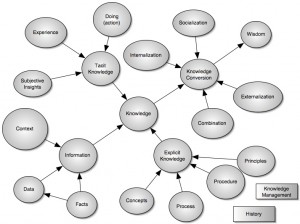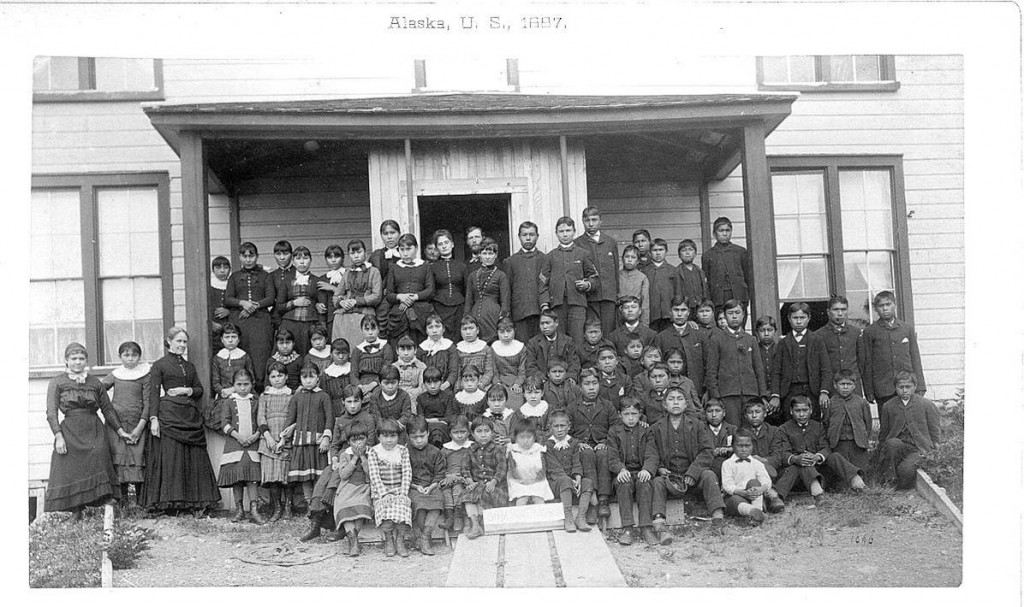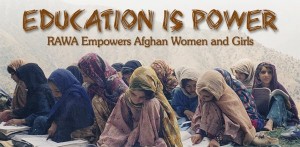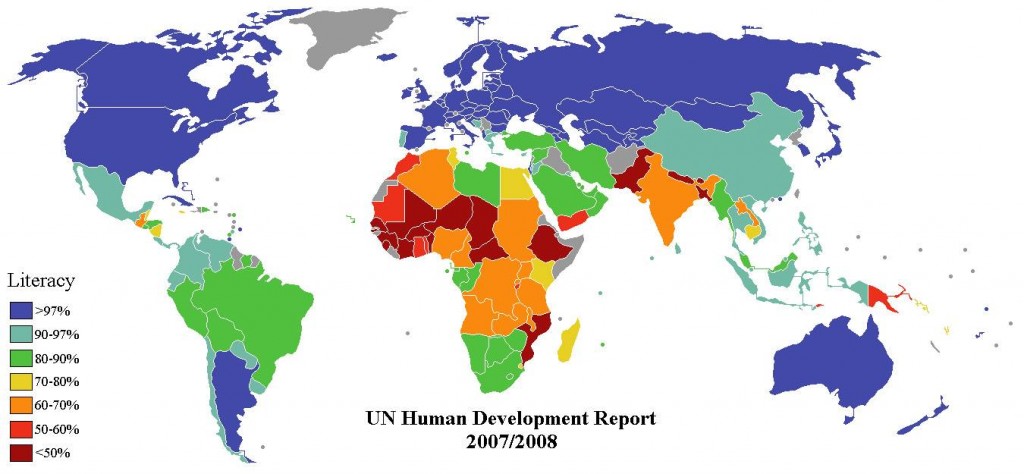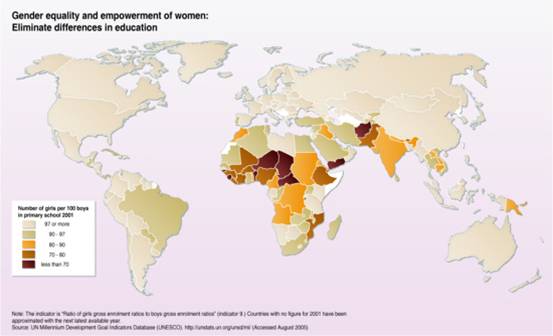Lesson Objectives:
- identify human-environment interactions
- define space and place
- evaluate the relationship between culture and the environment
- differentiate education, schooling and traditional ecological knowledge
- evaluate the relationship between conservation and global education programs
The human ability to create symbolic abstractions and systems of meaning is the defining characteristic that makes humans quite different from non-human primates. Yet, humans remain biological creatures that exist in an ecosystem, and like non-human primates, humans must extract resources from the ecosystem in order to meet basic needs and survive. This section will address the human relationship with the environment, both natural and built, and the social relations and systems of meaning that characterize human-environment interactions.
Human-Environment Interactions
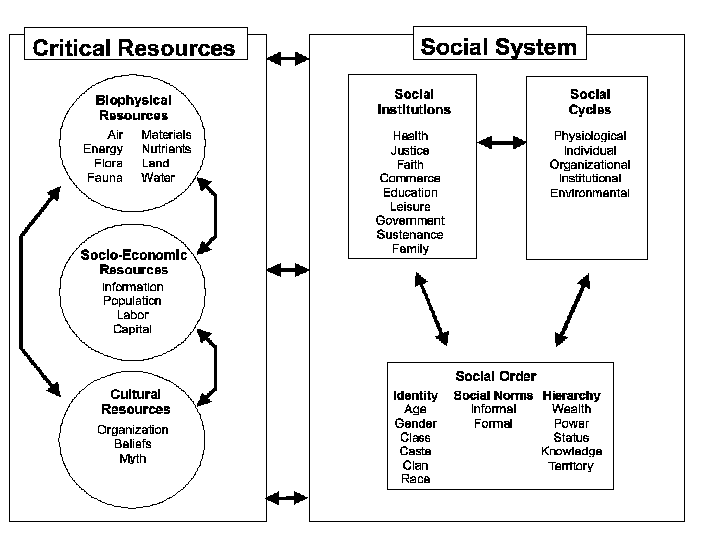 Human-Environment Interactions refers to the human relationship with the environment; This includes the ways that the environment affects the human experience as well as the ways that humans shape the environment (Harris 2012). The first module xplained how culture is a key part of human adaptation to different environments. The second module explained how people acquire resources from the environment by forming groups and engaging in adaptive strategies that are organized into livelihoods, or tasks and duties that are carried out within a social system. This places culture at the nexus between people and the environment because people interact with the environment according to cultural norms, values and the social organization of the society. Culture therefore shapes the ways that humans affect the environment. While at the same time, the environment shapes culture because it is the medium where people exist and it is the canvas for human perception because people living in different environments will view the world and construct reality very differently. This is why culture and the environment are inextricably linked.
Human-Environment Interactions refers to the human relationship with the environment; This includes the ways that the environment affects the human experience as well as the ways that humans shape the environment (Harris 2012). The first module xplained how culture is a key part of human adaptation to different environments. The second module explained how people acquire resources from the environment by forming groups and engaging in adaptive strategies that are organized into livelihoods, or tasks and duties that are carried out within a social system. This places culture at the nexus between people and the environment because people interact with the environment according to cultural norms, values and the social organization of the society. Culture therefore shapes the ways that humans affect the environment. While at the same time, the environment shapes culture because it is the medium where people exist and it is the canvas for human perception because people living in different environments will view the world and construct reality very differently. This is why culture and the environment are inextricably linked.
Space and Place
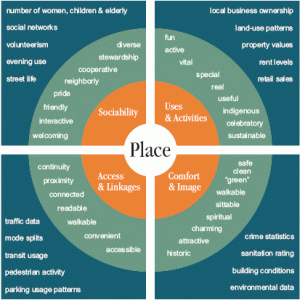 People perceive, organize and assign meaning to the environment, or space, through processes of ‘place-making’ (Low 2003; Tuan 2001). ‘Space’ is a geographical location that is arbitrary. Space becomes ‘place’ when humans assign meanings to space, and the meanings assigned to the space shape people’s expectations about the activities and behaviors that are appropriate in that space. For example, if people in Jacksonville create a building in a space and they call that building a ‘classroom’, a certain set of meanings have been assigned to that space to make it a place. Within that place called a classroom, there are a certain set of expectations regarding the human activities and behaviors in that place. There is usually a hierarchical social organization centered around a group of individuals called ‘students’ and an authoritarian leader called a ‘teacher.’ Individuals are usually expected to carry out specific tasks, to act a certain way, to dress a certain way. We wouldn’t expect to walk into the classroom and find everyone laughing, wearing bathing suits, and throwing a beach ball as we would if we entered a place called a ‘beach’. And when people leave the classroom place, they generally do not continue to carry out their roles as ‘teacher’ or ‘student’, but they modify their behavior according to the expectations of the places they occupy. Therefore, as people move and inhabit different places, they are constantly modifying and adapting their behavior according to the meanings and expectation associated with the places they encounter.
People perceive, organize and assign meaning to the environment, or space, through processes of ‘place-making’ (Low 2003; Tuan 2001). ‘Space’ is a geographical location that is arbitrary. Space becomes ‘place’ when humans assign meanings to space, and the meanings assigned to the space shape people’s expectations about the activities and behaviors that are appropriate in that space. For example, if people in Jacksonville create a building in a space and they call that building a ‘classroom’, a certain set of meanings have been assigned to that space to make it a place. Within that place called a classroom, there are a certain set of expectations regarding the human activities and behaviors in that place. There is usually a hierarchical social organization centered around a group of individuals called ‘students’ and an authoritarian leader called a ‘teacher.’ Individuals are usually expected to carry out specific tasks, to act a certain way, to dress a certain way. We wouldn’t expect to walk into the classroom and find everyone laughing, wearing bathing suits, and throwing a beach ball as we would if we entered a place called a ‘beach’. And when people leave the classroom place, they generally do not continue to carry out their roles as ‘teacher’ or ‘student’, but they modify their behavior according to the expectations of the places they occupy. Therefore, as people move and inhabit different places, they are constantly modifying and adapting their behavior according to the meanings and expectation associated with the places they encounter.
People can ascribe different meanings to the same place according to the different cultural contexts that the meanings are created. An Alaskan wilderness area might be considered a dangerous and harsh place for some or a location of peace and tranquility for others. A mosque can be a place of worship, family and security for some or a potential threat to others. The meanings ascribed to places and the expectations for human activities and behaviors vary significantly depending on the cultural context in which the meanings are created and ways that people interpret the meanings according to their personal experiences. The meanings ascribed to places are oftentimes projected onto the people who inhabit those places. This is sometimes the case with nationality, when the meanings and values associated with the geographic nation-state are presumed to characterize the citizens of the nation-state. People also take on meanings according to the places they shop, worship, live, recreate, etc., and the meanings people ascribe to themselves by virtue of inhabiting place (i.e. ‘I can shop here because I am successful’) can be quite different from the meanings ascribed by others (i.e. ‘He shops there because he is materialistic.’)
Environment and Knowledge
Environment plays a central role in knowledge because knowledge of a compendium of how people perceive the world they live in. According to the Oxford English Dictionary (2011), knowledge is:
- Expertise and skills acquired by a person through experience or education;
- What is known in a particular field or in total; facts and information;
- Awareness or familiarity gained by experience of a fact or situation.
Like culture, knowledge is learned and shared, and knowledge acquisition involves complex cognitive processes. It demands perception because people must be aware and conscious of their environment in order to process information. It requires the ability to retain information as it is received. It requires communication because knowledge is a body of information that accumulates through time and is shared through generations. It also requires association because as people receive new information, they must situate it in relation to their pre-existing system of collected information. If the new information does not fit, they either reject it and maintain the existing knowledge order or restructure their body of knowledge and thinking in order to accommodate the new information. The theory of human evolution, for example, can contradict the body of knowledge surrounding creationism. When a child who received a body of knowledge centered on creationism acquired new information about human evolution as an adult, they either choose to reject it, or restructure their existing body of knowledge to accommodate it. The same can occur with information about race. If a child learns certain ideas about ‘races’, and it later confronted with information that contradicts those ideas, they can reject the new information or restructure their current set of ideas in order to accommodate the new information.
Education & Schooling
There are many different bodie of knowledge, and knowledge is shared through the process of education, which is the acquisition of knowledge throughout the course of life. The educational process generally requires the presence of teachers or mentors who shared their knowledge with others through a series of interactive techniques. Education is sometimes organized into subjects, such as ‘reading,’ ‘math,’ ‘hunting,’ ‘gathering,’ ‘irrigation,’ and so on. However, education is not synonymous with schooling, which is an institution established to perpetuate a systematic set of ideas and criteria associated with knowledge as it relates to a particular society. Schools play a fundamental role in the social organization of society because it acts a social institution that lends authority to a particular knowledge system by which all members of the community are expected to recognize. Knowledge systems within school systems are formalized and standardized, this is important because it means that the information presented and learner assessments remain the same for everyone regardless of different experiences or perspectives. The information is usually codified through writing which necessitates literacy. The first evidence of schooling is found a 5000 year old Egyptian mural.
The role of schools in granting authority to a particular set of ideas places schools in a central position for socialization (Oakley 1972). Historically, schooling and formal education have been associated with ‘civilization.’ During the colonial period, European imperialists and missionaries used schools as a means to enculturate indigenous people, particularly children. In many cases, indigenous children were forced to attend boarding schools and forbidden to speak their indigenous language or participate in their indigenous culture.
Sheldon Jackson College in Sitka, Alaska is a former boarding school where Tlingit children were forced to learn a European way of life and receive a European-based education. After coming of age and returning to their villages, they were not able to integrate back into the Tlingit community because they were not familiar with the Tlingit language, culture or values that bonded members of the group. At they same time, they were not able to integrate into the European community due to inequality and discrimination. Today, they are referred to as the ‘Lost Generation.’
Forced schooling for indigenous children in Australia continued well into the 1970s. Children were often ‘kidnapped’ from their villages and taken to distant schools to be come socialized, or ‘civilized,’ according to a European way of life. Authorities padi particular attention to children who were of both ‘white’ and ‘aboriginal’ ancestry. The docu-drama, Rabbit-Proof Fence (2005), tells the story of three young girls who were taken and escaped from a state boarding school in Australia during the late 70s.
Critics argue that schools are the locus for the socialization, or conformity, to hegemonic ideological paradigms. They are particularly powerful because they primarily focus on children. Ann Oakley (1972) was among the first to argue that children receive more than purely ‘academic’ training when they attend schools; they are also socialized to prevailing norms and values that are based on white, heterosexual male standards. This is evidenced from ‘dress codes’ and other forms of regulations that sanction disciplinary action against students who defy accepted activities and behaviors. Along the same lines, Louis Althusser referred to the state education institution as an ‘ideological state apparatus’ (ISA) that indoctrinated youth to hegemonic ideologies in order to facilitate state control. At the same time, post-colonial states have relied on state schools to promote national identity in order to mitigate ethnic violence which became epidemic among formers colonies that were subjected to colonial ‘divide and rule’ policies. The documentary, ‘Schooling the World,’ interrogates the way that schools have been used as a means of dominating and oppressing indigenous groups.
At the same time, researchers have pointed out that schools can help unify a nation and mend ethnic divisions. Ghana was the first African colony to achieve Independence in the 20th century, and the new state established dozens of secondary boarding schools in rural areas. Although the state educational system has been fraught with problems associated with underfunding, many claim that the school system has helped narrow ethnic cleavages and contributed to the stability of the nation (Obeng). However, the Ghanaian school system is based on the former colonial model and the English language which has threatened cultural diversity and traditional ecological knowledge systems.
Traditional Ecological Knowledge (TEK)
Traditional ecological knowledge (TEK) refers to indigenous bodies of knowledge and information about the environment and human-environment interactions. TEK is generally place-based, meaning that it is relevant to localized circumstances and conditions. This is because TEK is acquired through interaction, observation and experiences that have accumulated through years of learning and sharing from generation to generation. TEK is usually transmitted orally, without a written language, and it is therefore becoming increasingly endangered. As globalization and development promote and expand euro-centric knowledge systems through schooling and education, TEK is often abandoned in favor of more globalized systems that lend greater promise to job opportunities and economic prosperity in the global economy.
Language is central to TEK because localized information is coded, or stored, in the words and meanings that comprise the local lexicon. The first module addressing language pointed out that language structures the way people view their environment, but the environment also shapes the structure of language. This is why language, culture and environment are inextricably linked; areas with high biodiversity also host high cultural diversity. At the same time, biological destruction can impact cultural/linguistic diversity. When the environment is destroyed, the language and cultural systems linked to the environment are changed. Similarly, culture and language loss can impact the environment because it changes the human-environment relationship. Of approximately 7,000 remaining languages, about 20% in danger of extinction.
The documentary film, Taking Root (2009), tells the story of Wangari Maathai the founder of the Green Belt Movement in Kenya. Maathai recognized that the experience of colonialism changed the human-environment relationship. She correlated the exploitation of people with exploitation of the environment. She aimed to tackle the post-colonial dictatorship and massive ecological destruction, both of which were generating human suffering, by mobilizing women in rural villages to start planting trees.
Throughout the documentary, Maathai explains how the experience of colonialism changed the way indigenous people in Kenya viewed the environment. Trees became timber, elephant tusks became ivory. The environment was no longer viewed as something to live in, but to extract from. Planting trees helped reconnect people to the environment that supported them.
Environment, Knowledge and Power
Knowledge is embedded in systems of power. In his book, Archaeology of Knowledge (1969) Michel Foucault describes three fundamental aspects of the relationship between knowledge and power; 1.) Knowledge is never neutral. This is because knowledge is created within a particular social system. 2.) Power is based on knowledge, and therefore acquiring knowledge is empowering. 3.) Power reproduces knowledge, and shapes it according to anonymous intentions. Anonymity is cloaked under the guise of objectivity. While people are aware of ideas that are accepted as ‘Truths’, most are unaware of the people who created those ideas and the motivations behind them.
This forces us to ask, Who decides on the body of knowledge?In the contemporary era, education is largely embedded in economics, and educational frameworks have become internationalized through processes of globalization and development. This is a serious point of contention in places like Afghanistan and Iraq, where the education systems and schools are viewed as encroachment and occupation. This BBC news report describes how girls’ schools are caught in the political crossfire in Afghanistan: http://news.bbc.co.uk/2/hi/8308151.stm
Research has shown that earnings increase with schooling (Mincer 1970), and many scholars argue that education will empower marginalized populations such as women (Moghadam 2005). Literacy programs targeting poor people in low-income nations have become a top priority with international development institutions and non-profit agencies. Education and literacy is considered a key part of poverty alleviation. At the same time however, anthropologists and environmentalists have argued that globalized education programs impact biological and cultural diversity.
In her book, Women and Plants (2003), Patricia Howard shows how the exclusion of rural women from economic development and education has placed women at the center of biological conservation. In many rural areas throughout the world, villages are primarily populated with women because men have migrated to urban centers to seek employment. Since men are usually positioned as income-earners, families choose to send their send to receive a formal education. As a result, girls learn TEK from their mothers as they continue to carry out localized tasks and livelihoods. In addition, children learn indigenous language, or the ‘mother tongue’, from their mother. In light of this, Howard argued that environmental conservation policies and practices must include the involvement of rural women.
Can you identify a pattern in the global distribution of illiteracy and gender inequality?
The significant role of women in conserving traditional ecological knowledge and the environment creates a thorny dilemma in terms of women’s empowerment. Economic exclusion has helped women retain TEK, and education and employment can endanger TEK and indigenous languages. While at the same time, literacy and education offers status and power. For many, literacy is perceived as a human right. This dilemma will be the topic of discussion below.
Readings: Howard, Patricia. Women and Plant Biodiversity
Your Score:
Your Ranking:
Discussion: After watching the documentary, Schooling the World (2010), Consider the relationship between power, knowledge and education, and contemplate the importance of traditional ecological knowledge in bio-cultural conservation. What is your perspective on the implications of global literacy programs for rural women living in peripheral areas? Do they empower women and increase opportunities or do they enforce the dominant hegemonic knowledge system? If you worked for an international agency tackling this problem, what type of recommendations would you provide to design a program that would empower women through education while conserving traditional ecological knowledge systems? Use the material in this lesson and the information presented in the readings to support your argument.

